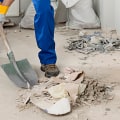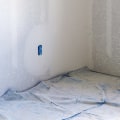Construction plays a vital role in urban development, infrastructure expansion, and economic growth, but it also has significant health implications for workers, nearby residents, and the environment. From exposure to hazardous materials and air pollution to noise disturbances and physical injuries, the effects of construction on health are wide-ranging and often overlooked. Understanding the risks and implementing measures to minimize health hazards is crucial in ensuring safer work environments and protecting public health. Whether through improved safety regulations, better air quality control, or post-construction cleaning efforts, addressing the health impact of construction is essential for sustainable development.
Air Quality and Respiratory Health Risks
One of the most concerning health effects of construction is the impact on air quality. Construction sites release large amounts of dust, debris, and airborne pollutants, which can pose serious respiratory health risks to workers and nearby communities. Fine particulate matter from cement, silica, and other materials can become airborne and contribute to respiratory conditions such as asthma, bronchitis, and lung infections. Prolonged exposure to airborne pollutants can lead to chronic lung diseases, particularly for workers who are in close contact with dust and fumes daily. Additionally, older buildings being demolished or renovated may contain asbestos, which, when disturbed, releases toxic fibers that can cause severe lung conditions, including asbestosis and mesothelioma. Proper dust control measures, protective equipment, and post-construction cleaning are necessary to reduce air pollution and protect respiratory health.
Noise Pollution and Its Effects on Health
Construction sites are often associated with excessive noise pollution from heavy machinery, drills, jackhammers, and other loud equipment. Constant exposure to high noise levels can lead to hearing loss, increased stress levels, sleep disturbances, and even cardiovascular issues. Construction workers are particularly at risk, as long-term exposure to loud noises can result in permanent hearing damage if proper hearing protection is not used. Nearby residents may also experience adverse effects from continuous construction noise, leading to sleep deprivation and heightened stress levels. Implementing noise reduction strategies, such as using sound barriers and scheduling work during less disruptive hours, can help mitigate these health risks.
Physical Injuries and Workplace Safety
Construction is one of the most hazardous industries in terms of physical injuries and workplace accidents. Falls, equipment malfunctions, electrocution, and exposure to hazardous chemicals are common risks that workers face on construction sites. Without proper safety protocols and protective gear, injuries can range from minor cuts and bruises to life-threatening conditions. Musculoskeletal injuries caused by repetitive motions, heavy lifting, and prolonged physical labor are also prevalent among construction workers, leading to chronic pain and long-term mobility issues. Enforcing strict safety measures, providing adequate training, and ensuring access to personal protective equipment can significantly reduce the risk of injuries and create a safer work environment.
Water Contamination and Environmental Impact
Construction activities can also lead to water contamination, affecting both human health and the surrounding ecosystem. Chemicals, solvents, and construction debris can find their way into nearby water sources, polluting drinking water and harming aquatic life. Runoff from construction sites can carry pollutants such as lead, oil, and pesticides into rivers and lakes, increasing the risk of waterborne diseases. Ensuring proper waste disposal, using eco-friendly building materials, and implementing erosion control measures can help prevent water contamination and protect both human health and the environment.
The Importance of Post-Construction Cleaning
Once construction projects are completed, thorough post-construction cleaning is essential to remove dust, debris, and hazardous residues that may linger in the environment. Leftover construction materials, chemical residues, and airborne pollutants can continue to pose health risks if not properly cleaned. Professional cleaning services, such as Dahlia Exterior Cleaning, LLC, specialize in removing harmful dust, washing exterior surfaces, and ensuring that newly built or renovated spaces are safe for occupancy. Investing in post-construction cleaning not only enhances the aesthetic appeal of buildings but also reduces health hazards, making the space safer for residents, workers, and visitors.
Conclusion: Balancing Construction and Health
While construction is essential for urban development and progress, it comes with several health risks that must be addressed. From air and noise pollution to physical injuries and environmental contamination, the impact of construction on health is far-reaching. By implementing effective safety measures, using eco-friendly materials, and prioritizing post-construction cleaning, it is possible to reduce these risks and create healthier living and working environments. Awareness and proactive solutions can help ensure that construction projects contribute positively to communities without compromising public health.



